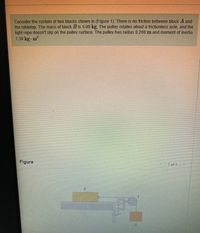Question

Transcribed Image Text:Consider the system of two blocks shown in (Figure 1). There is no friction between block A and
the tabletop. The mass of block B is 5.00 kg. The pulley rotates about a frictionless axle, and the
light rope doesn't slip on the pulley surface. The pulley has radius 0.200 m and moment of inertia
1.30 kg m
Figure
1 of 1

Transcribed Image Text:Part A
If the pulley is rotating with an angular speed of 8.00 rad/s after the block has descended 1.20 m, what is the mass of block A?
Express your answer with the appropriate units.
Valre
Units
Expert Solution
This question has been solved!
Explore an expertly crafted, step-by-step solution for a thorough understanding of key concepts.
This is a popular solution
Trending nowThis is a popular solution!
Step by stepSolved in 4 steps

Knowledge Booster
Similar questions
- A potter is shaping a bowl on a a potter’s wheel. The wheel rotaes at a constant angular speed. The frictional force between her hands and the clay is 2.25 N. How large is the torque she produces on the wheel if the diameter of the bowl is 14 cm.arrow_forwardIn the figure, two 6.90 kg blocks are connected by a massless string over a pulley of radius 1.10 cm and rotational inertia 7.40 x 10-4 kg-m². The string does not slip on the pulley; it is not known whether there is friction between the table and the sliding block; the pulley's axis is frictionless. When this system is released from rest, the pulley turns through 0.900 rad in 148 ms and the acceleration of the blocks is constant. What are (a) the magnitude of the pulley's angular acceleration, (b) the magnitude of either block's acceleration, (c) string tension T1, and (d) string tension T2? Assume free-fall acceleration to be equal to 9.81 m/s?. (a) Number i Units (b) Number Units (c) Number Units (d) Number Units >arrow_forwardA 1.0-kg mass hangs on a rope wrapped around a frictionless disk pulley of mass 5 kg and radius 0.5 m. What is the acceleration of the mass? (The moment of inertia of the pulley is 1/2MR2.)arrow_forward
- Two wheels are connected by a belt that does not slip. The smaller wheel has a diameter D, while the bigger wheel has a diameter that is 4.00 times bigger. Calculate the ratio of the moments of inertia if the two wheels have: i) the same angular momentum about their rotation axes. ii) the same rotational kinetic energy.arrow_forwardA frictionless pulley has the shape of a uniform solid disk of mass 2.90 kg and radius 10 cm. A 1.30 kg stone is attached to a very light wire that is wrapped around the rim of the pulley (the figure (Figure 1)), and the system is released from rest. How far must the stone fall so that the pulley has 3.40 J of kinetic energy? What percent of the total kinetic energy does the pulley have?arrow_forwardNeeds Complete typed solution with 100 % accuracy.arrow_forward
arrow_back_ios
arrow_forward_ios